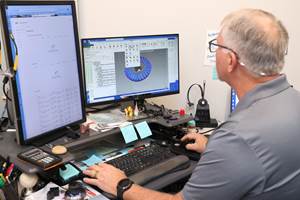New CAM Technology Links Knowledge And Solid Modeling
Some CAM developers are beginning to integrate the power of solid modeling with intelligent manufacturing applications that "know" how shops want to machine their parts.
Share





Solid modeling technology has made big inroads into the CAD world over the last decade for several reasons. Solid modeling has been of limited use on the CAM side of the equation, however, because it didn't bring all that much to the table for someone who mostly just wants to create tool paths.
But that's changing rapidly now that some CAM developers are beginning to integrate the power of solid modeling with intelligent manufacturing applications that "know" how shops want to machine their parts. A good example of such technology is EdgeCam for Mechanical Desktop, recently introduced by Pathtrace Systems, Inc. (Ontario, California). The new CAM software comes fully integrated with Mechanical Desktop, Autodesk's parametric, feature-based solid and surface modeling system. This combination makes it possible to directly machine solid models and to automate much of the NC programming process, says the developer.
Much of the automation capabilities stem from the system's ability to automatically extract manufacturing information such as features, material, volume and inside/outside references from solid models. Manufacturing operations can then be automatically applied to workpiece features, which reduces the time it takes to generate a part program.
A simple example of how this capability functions is a hole-drilling cycle. Once the user identifies a feature as a drilled hole, the system automatically picks up the hole diameter and depth from the model, selects an appropriate tool, and applies the correct feeds and speeds for the material being cut.
As features get more complex, the programming time savings grow more significant. For example, it had once taken over 20 operator instructions to program a threaded hole once all the tools and process parameters were selected for drilling, countersinking, counterboring, and tapping. Now that entire process can be programmed as a single operation.
The system includes knowledge-base libraries that help automate a range of machining processes. For example, tool libraries establish the cutting parameters used for tool path verification. A material library contains data for rough, medium and fine cuts, including depth of cut, chip load and suggested cutting speed (surface speed or rpm). An override feature provides compen-sation for material and fixture rigidity.
The system comes with a number of common manufacturing operations preloaded. But changes to the knowledge-base defaults can be made at any time so that processes can be made to conform to a shop's preferred methods.
Another advantage of integrating CAM with a solid modeler is a higher degree of data integrity, says the developer, because geometry is not filtered through a translator. Moreover, tool paths are saved with the model, so a single part file is used for all design and manufacturing data. Associativity allows tool paths to be automatically updated when changes are made to the model. This capability lends itself to concurrent engineering environments where companies want to determine manufacturability early in the design cycle, and also need to have a means to efficiently modify the manufacturing data as new designs are finalized.
The system can be used to verify the entire machining process. Verification displays not just the tool paths, but the stock, clamps and fixtures as solids, and solid tools interactively remove material from stock to identify collisions and gouging.
EdgeCam for Mechanical Desktop runs on Windows 95 and NT platforms. The standard package supports up to three-axis milling, two-axis turning and two-axis wire EDM. An advanced package supports up to five-axis milling, rotary and multiplane machining, four-axis turning (C and Y axis) and four-axis EDM.
For more information call (909) 460-5522 .
Related Content
How this Job Shop Grew Capacity Without Expanding Footprint
This shop relies on digital solutions to grow their manufacturing business. With this approach, W.A. Pfeiffer has achieved seamless end-to-end connectivity, shorter lead times and increased throughput.
Read MoreThe Power of Practical Demonstrations and Projects
Practical work has served Bridgerland Technical College both in preparing its current students for manufacturing jobs and in appealing to new generations of potential machinists.
Read MoreTTI Brings Specialty Gear Production In-House with Multiaxis Machining
By investing in a 3+2-axis machine and utilizing simulation software for diagnostic checks, Techtronic Industries turned a four- to ten-week lead time into a one- to two-week lead time.
Read MoreBlueprints to Chips: CAD/CAM Tips and Tricks
This collection of articles delves into the latest CAD/CAM innovations, from AI-driven automation and optimized tool paths to the impact of digital twins and system requirements.
Read MoreRead Next
AMRs Are Moving Into Manufacturing: 4 Considerations for Implementation
AMRs can provide a flexible, easy-to-use automation platform so long as manufacturers choose a suitable task and prepare their facilities.
Read MoreMachine Shop MBA
Making Chips and Modern Machine Shop are teaming up for a new podcast series called Machine Shop MBA—designed to help manufacturers measure their success against the industry’s best. Through the lens of the Top Shops benchmarking program, the series explores the KPIs that set high-performing shops apart, from machine utilization and first-pass yield to employee engagement and revenue per employee.
Read More




















